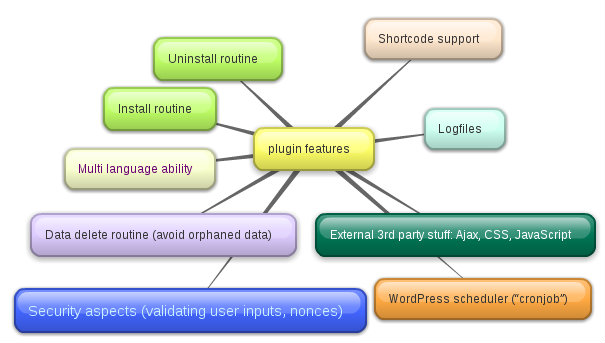WordPress Plugin template analysis
Here we will set the basic elements WordPress plugin should contain. We will not bother with the implementation details. We will simple try to understand the possible and the needed functionality of any WordPress plugin. Our analysis will mainly be based on the Empty Plugin Template that one can find here. Here is what is stated for this plugin and we will also examine here if this is correct list including:
- Multi language ability
- Uninstall routine
- Data delete routine (avoid orphaned data)
- Coding advices
- Security aspects (validating user inputs, nonces)
- External third party stuff (Ajax, CSS, Javascript)
- Shortcode
- WordPress scheduler (“cronjob”)
- Logfiles
First there are just several pages:
ept_logfilehandling.php
ept.php
ept_settings_page2.php
ept_settings_page.php
images
lang
readme.txt
Where images and lang are images and language folders. So there are just a few files and such a great features list. First the constants:
// some definitions used
define( 'EPT_PLUGIN_NAME', 'EPT Empty Plugin Template');
define( 'EPT_PLUGIN_DIRECTORY', 'empty-plugin-template');
define( 'EPT_CURRENT_VERSION', '0.1.1.1' );
define( 'EPT_CURRENT_BUILD', '3' );
define( 'EPT_LOGPATH', str_replace('\\', '/', WP_CONTENT_DIR).'/ept-logs/');
define( 'EPT_DEBUG', false); # never use debug mode on productive systems
// i18n plugin domain for language files
define( 'EMU2_I18N_DOMAIN', 'ept' );
In there we have the switch to include the log files or no
// how to handle log files, don't load them if you don't log
require_once('ept_logfilehandling.php');
In there three hooks have been set.
register_activation_hook(__FILE__, 'ept_activate');
register_deactivation_hook(__FILE__, 'ept_deactivate');
register_uninstall_hook(__FILE__, 'ept_uninstall');
Here is how the three hooks have been implemented:
// activating the default values
function ept_activate() {
add_option('ept_option_3', 'any_value');
}
// deactivating
function ept_deactivate() {
// needed for proper deletion of every option
delete_option('ept_option_3');
}
// uninstalling
function ept_uninstall() {
# delete all data stored
delete_option('ept_option_3');
// delete log files and folder only if needed
if (function_exists('ept_deleteLogFolder')) ept_deleteLogFolder();
}
Here is how the menu and submenu items have been set using the functions add_menu_page and add_submenu_page.
function ept_create_menu() {
// create new top-level menu
add_menu_page(
__('HTML Title', EMU2_I18N_DOMAIN),
__('HTML Title', EMU2_I18N_DOMAIN),
0,
EPT_PLUGIN_DIRECTORY.'/ept_settings_page.php',
'',
plugins_url('/images/icon.png', __FILE__));
add_submenu_page(
EPT_PLUGIN_DIRECTORY.'/ept_settings_page.php',
__("HTML Title", EMU2_I18N_DOMAIN),
__("Menu title", EMU2_I18N_DOMAIN),
0,
EPT_PLUGIN_DIRECTORY.'/ept_settings_page.php'
);
add_submenu_page(
EPT_PLUGIN_DIRECTORY.'/ept_settings_page.php',
__("HTML Title2", EMU2_I18N_DOMAIN),
__("Menu title 2", EMU2_I18N_DOMAIN),
9,
EPT_PLUGIN_DIRECTORY.'/ept_settings_page2.php'
);
// or create options menu page
add_options_page(__('HTML Title 3', EMU2_I18N_DOMAIN), __("Menu title 3", EMU2_I18N_DOMAIN), 9, EPT_PLUGIN_DIRECTORY.'/ept_settings_page.php');
// or create sub menu page
$parent_slug="index.php"; # For Dashboard
#$parent_slug="edit.php"; # For Posts
// more examples at http://codex.wordpress.org/Administration_Menus
add_submenu_page( $parent_slug, __("HTML Title 4", EMU2_I18N_DOMAIN), __("Menu title 4", EMU2_I18N_DOMAIN), 9, EPT_PLUGIN_DIRECTORY.'/ept_settings_page.php');
}
Now the register_settings function is part of the WordPress Settings API function enabling the users to automatically generate dashboard settings page. It works right out of the box for all the standard data types, and there are no restrictions if you plan to customize the layout of the form controls.
function ept_register_settings() {
//register settings
register_setting( 'ept-settings-group', 'new_option_name' );
register_setting( 'ept-settings-group', 'some_other_option' );
register_setting( 'ept-settings-group', 'option_etc' );
}
// check if debug is activated
function ept_debug() {
# only run debug on localhost
if ($_SERVER["HTTP_HOST"]=="localhost" && defined('EPS_DEBUG') && EPS_DEBUG==true) return true;
}
Actually this was all in found in the Empty Plugin Template WordPress plugin at Jan 1st 2013th. Probable some features from the list above are still missing.
[caption id=”attachment_980” align=”alignnone” width=”605”] Plugin features[/caption]
Plugin features[/caption]
…
tags: & category: -
